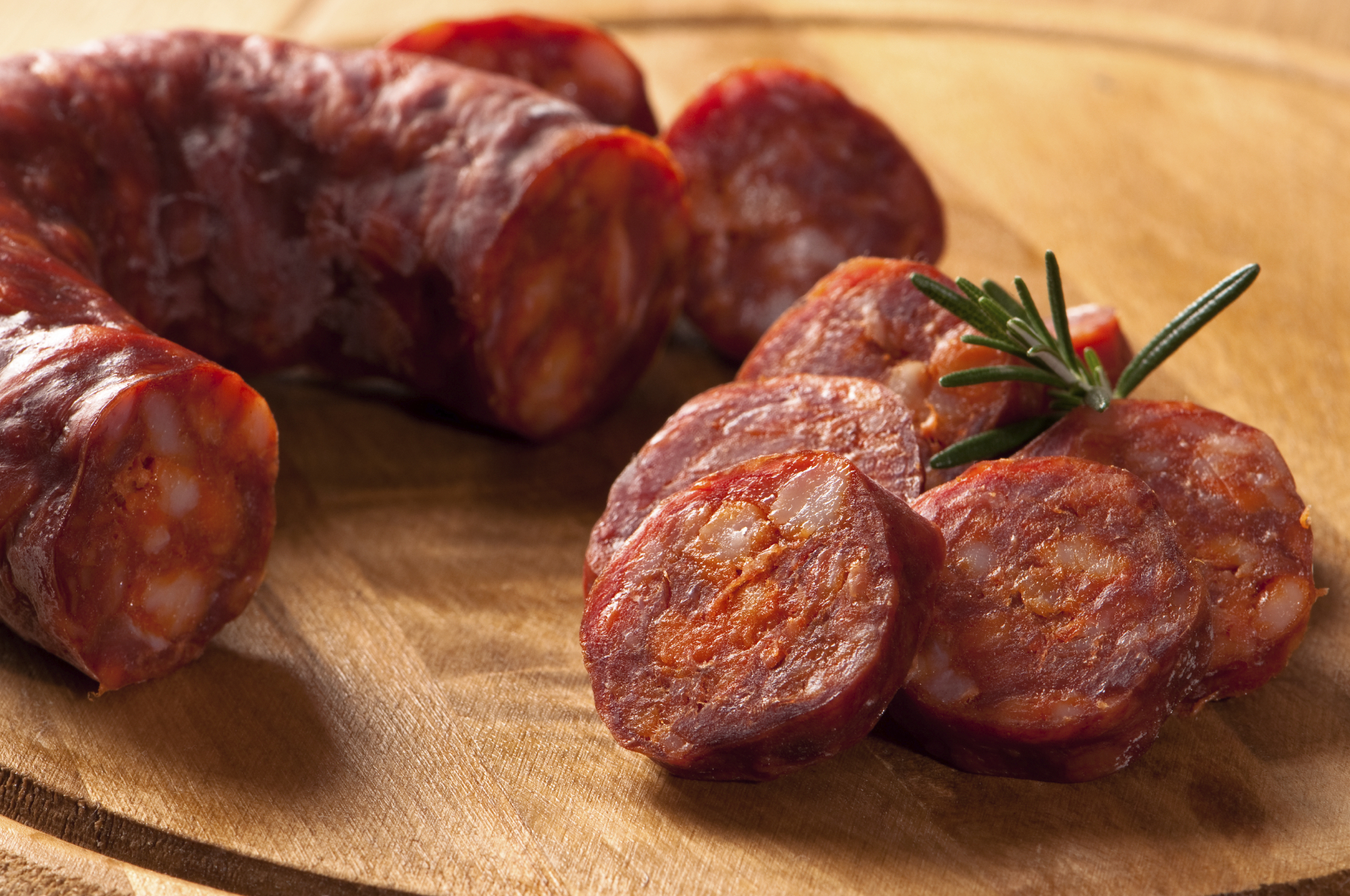Chorizo
Chorizo [ tʃo'ɾiθo ] ( Spanish), Chouriço ( Portuguese) or Xoriço [ ʃu'ɾisu ] (Catalan ) is a spicy, strong, coarse-grained, seasoned with paprika and garlic dry sausage of pork from Spain and Portugal. The paprika gives it a red color and contributes to the characteristic flavor at. Chorizo typically contains up to twice as much pepper as also spiced with paprika Hungarian Kolbász.
Word origin
The origin of the word chorizo is unclear. Maybe it comes from the Latin salsicium ( " sausage ").
In Spanish chorizo is also used as a term of abuse for a small thief or fraudster.
Spain
In Spain about 64,000 tons of chorizo are produced annually. The chorizo is usually offered as a sausage ring or unset string of sausages. It is used as meats, cooked in stews, as a tapa is very popular. You will also grilled, eaten fried or smoked. Occasionally it is also cooked in cider ( Sidra ), inserted in lard or olive oil and enjoyed so. In some regions of Spain it reaches the chorizo with nutmeg, oregano, thyme, pepper, potatoes and onions. In the commercial variants of turkey meat ( chorizo de pavo ) are offered.
Production
In the production of meat and bacon are chopped small, often come offal from pigs to. The mass is seasoned with salt, pepper ( paprika primarily de la Vera) and garlic flavored, depending on regional habits, other spices ( eg oregano) added. The flavor of the sausage varies depending on which Pepper type ( mild, slightly sweet, spicy, extra spicy, smoked, sun- dried). The sausage is then typically dried in specialized drying rooms at a temperature between five and ten degrees Celsius in air. In this four to six weeks of ripening, the chorizo is solid and gets its distinctive taste. Since during maturation also takes place fermentation ( fermentation), a slightly sour taste is established which blends well with the edge of the sausage.
The finished sausages are classified into one of four levels of quality, of which reach only the two best " Primera " and " Extra" in export.
Regional variations
The most famous version is the chorizo riojano. It is protected by a designation of origin. For the preparation of meat and fat of castrated white pigs are used. In contrast, the chorizo ibérico made from the meat of black Cerdo Ibérico - pigs - an ancient Iberian breed that is closely related to the wild boar. Other popular varieties are asturiano chorizo , chorizo de Pamplona, Chorizo de Cantimpalos from Segovia, Soria de chorizo , chorizo extremeño and the chorizo de Zamora. Rather than local curiosity chorizo is made from wild boar, deer, goat or lamb.
Portugal
In Portugal, the sausage is called Chouriço and is as popular as in Spain. The Portuguese Chouriço is usually fat and contains less peppers. The meat for the production of the northern Portuguese Chouriço ( pork belly ) is inserted before smoking in red wine with garlic, salt and various spices. The meat for the filling of "good" Chouriço is very rough cut and should contain little fat. The südportugiesiche Chouriço similar to the Spanish version and includes more peppers. Chouriço Industrially produced often contains very fat and finely sliced meat.
A popular preparation method in Portugal, the Chouriço on a Assa Chouriço - to flambé - an often ornate small ceramic table grill shell; this is usually cheaper Aguardente or ethanol, but poured like to improve the taste of the sausage also indigenous Medronho in the drip pan of Assa and lit for a few minutes. The Chouriço is laterally inserted before this Flambiervorgang several times lengthwise, so that under the great influence of heat, the grease can escape into the grill pan.
Other countries
The largest Chorizo lovers outside of Spain and Portugal are the French. In France, about 7,000 to 9,000 tons of chorizo are produced in addition to the imports from Spain. The sausage is a little richer: While Spanish chorizo qualities of the Primera and Extra contains 20 to 30 percent fat, it is the French variant of around 45 percent. Unlike the Spanish version, the French chorizo is usually cut a little finer.
In Mexico and the Caribbean chorizo is also prepared. The meat is not chopped there usually but minced. Seasoned is not uncommon with cayenne pepper, black pepper, oregano and cumin. A popular breakfast in Mexico is chorizo con huevos ( chorizo with eggs ).
In South America, sausages are made under the name of chorizo or Chouriço. However, these are more different from the original Spanish or Portuguese, as they are less spicy. The chorizo in the Argentine asado are sausages. One can easily prepare yourself by mixed the sausage meat with chimichurri.
In the Philippines, there is also a variant of chorizo. It is slightly sweeter than the Spanish original.
In the small Indian state of Goa, there is a Chouriço, which dates back to the Portuguese colonial era. This is much darker and far sharper than other sausages that name. In East Timor, the former Portuguese Timor, Chouriços be made .
Also, German manufacturers have added the chorizo in their range.









